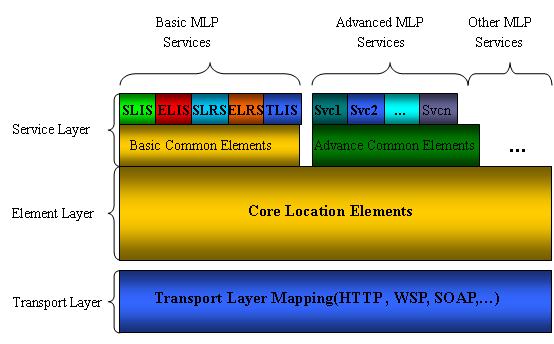Different devices may support different means of communication. A ubiquitous protocol for location services should support different transport mechanisms.
In MLP, the transport protocol is separated from the XML content. Figure 3.1 show a layered view of MLP.
(source : MLP specification [1])
On the lowest level, the transport protocol defines how XML content is transported. Possible MLP transport protocols include HTTP, WSP, SOAP, and others. MLP can be implemented using these various transport mechanism.
The second level is the Element Layer which defines all common elements. The services in the service layer could use them. MLP defines the following set of DTDs making up the element layer of MLP:
- MLP_ID.DTD Identify Element Definitions
- MLP_FUNC.DTD Function Element Definitions
- MLP_LOC.DTD Location Element Definitions
- MLP_RES.DTD Result Element Definitions
- MLP_SHAPE.DTD Shape Element Definitions
- MLP_QOP.DTD Quality of Position Element Definitions
- MLP_GSM_NET.DTD GSM Network Parameters Element Definitions
- MLP_CTXT.DTD Context Element Definitions
The top level is the Service Layer which defines the actual services offered by the MLP framework. Basic MLP Services are based on location services defined by 3GPP, and are defined by OMA/MLP (including SLIS,ELIS,SLRS,ELRS,TLIS,HLIS and they will be specified in the part of "features of MLP"). The "Advanced MLP Services" and "Other MLP Services" are additional services that either will be specified in other specifications or are specified by other fora that conform to the MLP framework.
